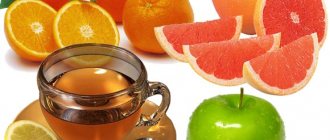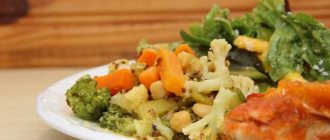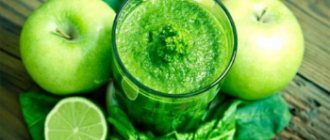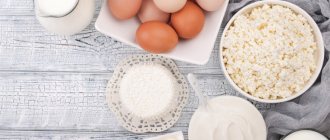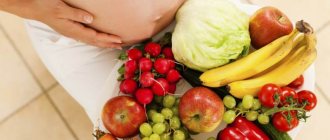Sergei Agapkin’s diet is a new way to lose weight, which is rapidly gaining popularity. How did the doctor and TV presenter manage to create such an effective method? The author studied and analyzed many different diets and took only the healthiest foods as the basis for his diet. Well-known domestic nutritionists helped create this course. It is not surprising that a diet based on the physiological needs of the body and built taking into account medical standards works.
The doctor insists on simple and well-known rules: eat only high-quality and fresh products, forget about overeating, do not forget about vitamins and microelements, and of course, exercise.
CALCULATORS FOR THOSE WHO WANT TO LOSE WEIGHT
General rules
Dr. Agapkin’s diet for weight loss is another fashionable diet program for weight correction, which has become widely known thanks to the television program “About the Most Important Thing,” hosted by Dr. Agapkin himself.
Unfortunately, despite the huge number of dietary programs, the problem of “excess” weight in society remains extremely relevant, which stimulates the search for new approaches to it. Recently, dietary programs developed using a combination of knowledge in various fields of medical sciences, in particular dietetics and psychology, have become especially valuable. It is the principles of these sections of medicine that are put into the system of life and nutrition of Sergei Agapkin, who is a doctor specializing in traditional systems of healing the body and having a second specialization in medical psychology, who defended his academic degree on the topic “The Concept of Psychosomatic Disorders in Tibetan Medicine.” Based on his large and diverse theoretical and practical knowledge, Dr. Agapkin analyzed a large number of dietary programs, which allowed him to collect and summarize the most useful nutritional recommendations for weight loss and develop his own system for correcting body weight, allowing him to achieve good results (an average of 6 kg in 7 days), and most importantly, learn to maintain your weight in a new “weight category”.
First of all, the author recommends avoiding various potentially dangerous mono-diets, which, if they have an effect, are short-lived, since the weight, as a rule, returns to its original levels. But harm from an unbalanced and often lacking diet of one or another essential nutritional nutrient can have a negative impact on metabolism both in general and its individual types, cause protein starvation, disrupt hormonal levels, reduce cognitive functions and performance of the body . Therefore, according to the doctor, a diet for weight loss should be based on a healthy lifestyle: balanced nutrition with dietary adjustments, adequate regular physical activity and an appropriate psychological attitude.
Moreover, the author believes that dietary nutrition should not be unified, since each person is individual in all its manifestations and, accordingly, menu selection must be made on the basis of the personal data of the person losing weight (age, gender, height, level of physical activity, indicators of excess of the physiological weight norm , health status, taste preferences). For those who do not have the opportunity to receive individual advice, the author has developed a number of rules for proper nutrition for weight loss.
Sergei Agapkin’s diet - 6 kg in 7 days includes:
- Forming a positive attitude toward a dietary program based on clear motivation that stimulates the transition to a new “eating behavior.”
- The diet should be formed on the principles of a balanced diet with a normal content of all the most important food macro/micronutrients. No mono-diets. The diet should include natural foods containing animal/plant proteins, fats, unsaturated fatty acids, complex carbohydrates and fiber. As much as possible, you should avoid consuming unhealthy foods - fatty meat, fast food, flour, canned food, semi-finished products, pasta, sausages, smoked products, sweets and confectionery, carbonated drinks, fried foods, packaged juices, alcohol. The place of such products should be taken by chicken meat, lean beef, low-fat cottage cheese, fish and seafood, chicken eggs, fermented milk products, whole grain cereals, cold-pressed vegetable oils, dried fruits, vegetables, fruits, bran, natural freshly prepared juices, garden herbs.
- Fractional (5-6 meals a day) diet, reduced portion size. This regimen will allow you to feel full without overeating. The last meal is 3-4 hours before bedtime. Sufficient fluid intake is 1.5-2 l/day in the form of green/herbal tea, juices, still mineral water.
- Compliance with the daily routine, in particular, a full 7-hour continuous night sleep. Because it is during the period of night rest that growth hormone is produced, which destroys fat cells.
- Adequate (age-appropriate) physical activity, mainly of the aerobic type (with oxygen absorption) - morning exercises, swimming, walking, yoga, cycling, cardio exercises.
Following these dietary and lifestyle principles will ensure gradual weight loss. According to the author, it is not necessary to stimulate the natural process of losing weight, since sudden weight loss disrupts the life support mechanisms familiar to each organism, promotes a rapid return to the initial weight and the development of various diseases.
Useful tips
Tip 1. In case of a breakdown, you don’t need to make the next day a fasting day or tighten your diet, just continue to eat according to the rules.
Tip 2. Sports activities should not be exhausting, but regular - at least twice a week.
Sergei Agapkin’s diet is a system of proper nutrition that allows you to achieve weight loss not through strict restrictions, but by improving the health of the body and activating metabolism. You can stick to it for as long as you like.
Authorized Products
The diet of Sergei Agapkin’s diet consists of the following products:
- Low-fat vegetable soup with chicken/vegetable broth.
- Lean red meat, skinless chicken, rabbit, turkey.
- Cottage cheese and low-fat fermented milk products.
- Vegetables with minimal starch content (cabbage, green beans, bell peppers, green peas, zucchini, asparagus, cucumber, garlic, onions, celery, lettuce, spinach, various types of garden herbs).
- Unrefined virgin vegetable oils (olive, flaxseed, sunflower).
- Whole grain porridge, brown rice.
- Sour fruits: citrus fruits, plums, apples, pears.
- Still mineral water, green herbal tea, vegetable smoothie, fruit rosehip decoction.
Table of permitted products
| Proteins, g | Fats, g | Carbohydrates, g | Calories, kcal | |
Vegetables and greens | ||||
| greenery | 2,6 | 0,4 | 5,2 | 36 |
| zucchini | 0,6 | 0,3 | 4,6 | 24 |
| broccoli | 3,0 | 0,4 | 5,2 | 28 |
| Brussels sprouts | 4,8 | 0,0 | 8,0 | 43 |
| cabbage | 1,2 | 0,2 | 2,0 | 16 |
| watercress | 2,3 | 0,1 | 1,3 | 11 |
| red onion | 1,4 | 0,0 | 9,1 | 42 |
| bulb onions | 1,4 | 0,0 | 10,4 | 41 |
| cucumbers | 0,8 | 0,1 | 2,8 | 15 |
| salad pepper | 1,3 | 0,0 | 5,3 | 27 |
| celery | 0,9 | 0,1 | 2,1 | 12 |
| tomatoes | 0,6 | 0,2 | 4,2 | 20 |
| dill | 2,5 | 0,5 | 6,3 | 38 |
| garlic | 6,5 | 0,5 | 29,9 | 143 |
Fruits | ||||
| baked sweet and sour apples | 0,5 | 0,5 | 12,3 | 59 |
Mushrooms | ||||
| mushrooms | 3,5 | 2,0 | 2,5 | 30 |
Cereals and porridges | ||||
| wheat bran | 15,1 | 3,8 | 53,6 | 296 |
Bakery products | ||||
| whole grain bread | 10,1 | 2,3 | 57,1 | 295 |
Raw materials and seasonings | ||||
| vinegar | 0,0 | 0,0 | 5,0 | 20 |
Dairy | ||||
| kefir 1% | 2,8 | 1,0 | 4,0 | 40 |
Cheeses and cottage cheese | ||||
| cottage cheese | 17,2 | 5,0 | 1,8 | 121 |
| cottage cheese 0% (low fat) | 16,5 | 0,0 | 1,3 | 71 |
Meat products | ||||
| lean beef | 22,2 | 7,1 | 0,0 | 158 |
| veal | 19,7 | 1,2 | 0,0 | 90 |
| rabbit | 21,0 | 8,0 | 0,0 | 156 |
Bird | ||||
| steamed chicken breast | 23,6 | 1,9 | 0,0 | 113 |
| boiled chicken fillet | 30,4 | 3,5 | 0,0 | 153 |
| turkey | 19,2 | 0,7 | 0,0 | 84 |
Eggs | ||||
| hard-boiled chicken eggs | 12,9 | 11,6 | 0,8 | 160 |
Fish and seafood | ||||
| boiled fish | 17,3 | 5,0 | 0,0 | 116 |
| squid | 21,2 | 2,8 | 2,0 | 122 |
| shrimps | 22,0 | 1,0 | 0,0 | 97 |
| mussels | 9,1 | 1,5 | 0,0 | 50 |
| seaweed | 0,8 | 5,1 | 0,0 | 49 |
| zander | 19,2 | 0,7 | — | 84 |
| cod | 17,7 | 0,7 | — | 78 |
| hake | 16,6 | 2,2 | 0,0 | 86 |
| pike | 18,4 | 0,8 | — | 82 |
Oils and fats | ||||
| vegetable oil | 0,0 | 99,0 | 0,0 | 899 |
| linseed oil | 0,0 | 99,8 | 0,0 | 898 |
Non-alcoholic drinks | ||||
| mineral water | 0,0 | 0,0 | 0,0 | — |
| instant chicory | 0,1 | 0,0 | 2,8 | 11 |
| green tea | 0,0 | 0,0 | 0,0 | — |
Juices and compotes | ||||
| rose hip juice | 0,1 | 0,0 | 17,6 | 70 |
| * data is per 100 g of product | ||||
Sample menu for a weight loss system from Sergei Agapkin
For breakfast, Agapkina’s diet menu advises eating a vegetable salad, an omelette of 2 eggs and 10 g of wheat bran. For second breakfast - 100 g of cottage cheese or yogurt combined with ½ pear, banana or apple. For lunch, Agapkin's diet menu offers stewed vegetables, baked fish or boiled chicken, a slice of bread and 100 g of wheat bran. The afternoon snack is identical to the second breakfast. And for dinner you are allowed to treat yourself to 100 g of boiled chicken, vegetable salad and a slice of bread.
According to reviews, the Agapkin diet makes it possible to lose from 1 to 3 extra pounds per week without experiencing any particular physical or psychological discomfort.
Do not forget that improper use of bran can disrupt the functioning of the intestines, cause bloating and simply feel unwell. If you have diseases of the gastrointestinal tract, consult your doctor before starting this weight loss method.
Fully or partially limited products
In the diet of Sergei Agapkin's diet, the following are excluded:
- Wheat bread and all bakery products, polished white rice, pastries, pancakes, pasta, dumplings, pancakes.
- Fatty meats, duck, goose, sausages, butter, canned meat/fish, smoked meats, mayonnaise, semi-finished products, animal fats (lard, bacon, lamb, pork, beef fat), fast food products.
- Fermented milk products with medium/high fat content.
- Products containing simple carbohydrates - condensed milk, sweets, jam, ice cream, jam, sugar, waffles, honey, confectionery, chocolate.
- Sweet fruits.
- Starchy vegetables (pumpkin, carrots, potatoes, corn, eggplant, beets, turnips).
- Sparkling mineral water, sweet drinks, alcohol, sweet coffee and black tea.
Table of prohibited products
| Proteins, g | Fats, g | Carbohydrates, g | Calories, kcal | |
Vegetables and greens | ||||
| vegetables legumes | 9,1 | 1,6 | 27,0 | 168 |
| potato | 2,0 | 0,4 | 18,1 | 80 |
| carrot | 1,3 | 0,1 | 6,9 | 32 |
| beet | 1,5 | 0,1 | 8,8 | 40 |
| horseradish | 3,2 | 0,4 | 10,5 | 56 |
Fruits | ||||
| bananas | 1,5 | 0,2 | 21,8 | 95 |
| melon | 0,6 | 0,3 | 7,4 | 33 |
| figs | 0,7 | 0,2 | 13,7 | 49 |
| mango | 0,5 | 0,3 | 11,5 | 67 |
Berries | ||||
| grape | 0,6 | 0,2 | 16,8 | 65 |
Nuts and dried fruits | ||||
| raisin | 2,9 | 0,6 | 66,0 | 264 |
| dates | 2,5 | 0,5 | 69,2 | 274 |
Snacks | ||||
| potato chips | 5,5 | 30,0 | 53,0 | 520 |
Cereals and porridges | ||||
| porridge | 3,3 | 1,2 | 22,1 | 102 |
| white rice | 6,7 | 0,7 | 78,9 | 344 |
Flour and pasta | ||||
| pasta | 10,4 | 1,1 | 69,7 | 337 |
| pancakes | 6,1 | 12,3 | 26,0 | 233 |
| vareniki | 7,6 | 2,3 | 18,7 | 155 |
| pancakes | 6,3 | 7,3 | 51,4 | 294 |
| dumplings | 11,9 | 12,4 | 29,0 | 275 |
Bakery products | ||||
| buns | 7,2 | 6,2 | 51,0 | 317 |
| wheat bread | 8,1 | 1,0 | 48,8 | 242 |
Confectionery | ||||
| jam | 0,3 | 0,2 | 63,0 | 263 |
| jam | 0,3 | 0,1 | 56,0 | 238 |
| candies | 4,3 | 19,8 | 67,5 | 453 |
| cookie | 7,5 | 11,8 | 74,9 | 417 |
| cake | 3,8 | 22,6 | 47,0 | 397 |
| jam | 0,4 | 0,2 | 58,6 | 233 |
| dough | 7,9 | 1,4 | 50,6 | 234 |
| halva | 11,6 | 29,7 | 54,0 | 523 |
Cakes | ||||
| cake | 4,4 | 23,4 | 45,2 | 407 |
Chocolate | ||||
| chocolate | 5,4 | 35,3 | 56,5 | 544 |
Raw materials and seasonings | ||||
| seasonings | 7,0 | 1,9 | 26,0 | 149 |
| mustard | 5,7 | 6,4 | 22,0 | 162 |
| ginger | 1,8 | 0,8 | 15,8 | 80 |
| mayonnaise | 2,4 | 67,0 | 3,9 | 627 |
| honey | 0,8 | 0,0 | 81,5 | 329 |
| sugar | 0,0 | 0,0 | 99,7 | 398 |
Dairy | ||||
| milk | 3,2 | 3,6 | 4,8 | 64 |
| milk 3.2% | 2,9 | 3,2 | 4,7 | 59 |
| condensed milk | 7,2 | 8,5 | 56,0 | 320 |
Cheeses and cottage cheese | ||||
| cheese | 24,1 | 29,5 | 0,3 | 363 |
| cottage cheese 18% (fat) | 14,0 | 18,0 | 2,8 | 232 |
Meat products | ||||
| fatty pork | 11,4 | 49,3 | 0,0 | 489 |
| pork fat | 1,4 | 92,8 | 0,0 | 841 |
| salo | 2,4 | 89,0 | 0,0 | 797 |
| bacon | 23,0 | 45,0 | 0,0 | 500 |
Sausages | ||||
| boiled sausage | 13,7 | 22,8 | 0,0 | 260 |
| smoked sausage | 28,2 | 27,5 | 0,0 | 360 |
| smoked sausage | 9,9 | 63,2 | 0,3 | 608 |
| sausages | 10,1 | 31,6 | 1,9 | 332 |
| sausages | 12,3 | 25,3 | 0,0 | 277 |
Bird | ||||
| smoked chicken | 27,5 | 8,2 | 0,0 | 184 |
| duck | 16,5 | 61,2 | 0,0 | 346 |
| goose | 16,1 | 33,3 | 0,0 | 364 |
Eggs | ||||
| eggs | 12,7 | 10,9 | 0,7 | 157 |
Fish and seafood | ||||
| fried fish | 19,5 | 11,7 | 6,2 | 206 |
| salted fish | 19,2 | 2,0 | 0,0 | 190 |
| caviar | 36,0 | 10,2 | 0,0 | 123 |
| Red caviar | 32,0 | 15,0 | 0,0 | 263 |
| cod roe | 24,0 | 0,2 | 0,0 | 115 |
| canned fish | 17,5 | 2,0 | 0,0 | 88 |
| semi-finished fish products | 12,5 | 6,7 | 14,7 | 209 |
Oils and fats | ||||
| butter | 0,5 | 82,5 | 0,8 | 748 |
| creamy margarine | 0,5 | 82,0 | 0,0 | 745 |
| coconut oil | 0,0 | 99,9 | 0,0 | 899 |
| vegetable-fat spread | 0,0 | 40,0 | 0,0 | 360 |
| animal fat | 0,0 | 99,7 | 0,0 | 897 |
| cod liver oil | 0,0 | 99,8 | 0,0 | 898 |
| cooking fat | 0,0 | 99,7 | 0,0 | 897 |
Alcoholic drinks | ||||
| white dessert wine 16% | 0,5 | 0,0 | 16,0 | 153 |
| vodka | 0,0 | 0,0 | 0,1 | 235 |
| cognac | 0,0 | 0,0 | 0,1 | 239 |
| liquor | 0,3 | 1,1 | 17,2 | 242 |
| beer | 0,3 | 0,0 | 4,6 | 42 |
Non-alcoholic drinks | ||||
| cola | 0,0 | 0,0 | 10,4 | 42 |
| coffee | 0,2 | 0,0 | 0,3 | 2 |
| Pepsi | 0,0 | 0,0 | 8,7 | 38 |
| sprite | 0,1 | 0,0 | 7,0 | 29 |
| energy drink | 0,0 | 0,0 | 11,3 | 45 |
| * data is per 100 g of product | ||||
Reviews and results
Reviews about Dr. Sergei Agapkin’s diet are mostly positive, since it is based on a healthy, balanced diet with limited calories.
- “... After I found Dr. Agapkin’s nutritional advice, I purchased a good pressure cooker, which allowed me to switch to a healthy diet, cooking dishes with a small amount of fat and a minimum of time. I have eliminated almost all “sweets”, with the exception of dark chocolate, and even then I only eat a small piece of it a day. Everything else is natural products, a lot of greens, vegetables and fruits. True, I almost gave up chicken and replaced it with rabbit and turkey meat, since, according to research, hormones and antibiotics are used in industrial chicken farming in quantities exceeding the norm. I introduced into my daily routine swimming in the pool 2 times a week and practicing on the orbit track at home in the morning. In a month I lost 6.2 kg and felt good. I recommend!".
- “... I came to this diet after a series of express diets, on which I quickly lost weight, but it was also quickly restored. I organized my diet and lifestyle, as recommended by the author of the diet. I didn’t expect quick results, but overall I lost 10 kg over the 3 summer months, but the most important thing is that six months have already passed, and my new weight is maintaining, which makes me very happy.”
Doctor Agapkin's diet: How to lose 6 kg in a week?
Completed postgraduate studies at the Central Research Institute of Epidemiology. Completed numerous advanced training courses in epidemiology and infectious diseases. Mikhail: What an uneducated person wrote this honey.
I really want to talk to him Nikolay: Tell me, have you been to the roasting shop of the Nickel Plant in Norilsk, or at the KCC or Lesya: If you missed the moment, the drug is useless.
It only helps when you start right away. All materials presented on the site are intended for educational purposes only and are not intended for medical advice, diagnosis or treatment.
The site administration, editors and authors of articles are not responsible for any consequences or losses that may arise when using site materials. Infectious and parasitic diseases Neoplasms Diseases of the blood and hematopoietic organs Diseases of the endocrine system Mental disorders Diseases of the nervous system Eye diseases Ear diseases Diseases of the circulatory system Diseases of the respiratory system Diseases of the digestive system Skin diseases Diseases of the musculoskeletal system Diseases of the genitourinary system Pregnancy and childbirth Diseases of the fetus and newborn Congenital anomalies developmental defects Trauma and poisoning.

